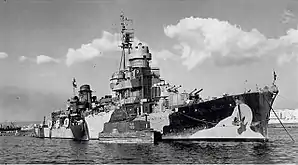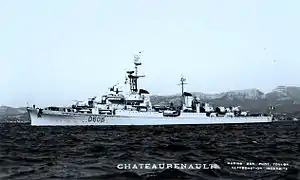Capitani Romani-class cruiser
The Capitani Romani class was a class of light cruisers acting as flotilla leaders for the Regia Marina (Italian Navy). They were built to outrun and outgun the large new French destroyers of the Le Fantasque and Mogador classes.[2] Twelve hulls were ordered in late 1939, but only four were completed, just three of these before the Italian armistice in 1943. The ships were named after prominent ancient Romans (Capitani Romani (lit. Roman Captains)).[3]
 Scipione Africano | |
| Class overview | |
|---|---|
| Name | Capitani Romani class |
| Operators | |
| Subclasses | San Giorgio class |
| Built | 1939–1942 |
| In commission | 1942–1980 |
| Planned | 12 |
| Completed | 4 |
| Cancelled | 8 |
| Scrapped | 4 |
| General characteristics | |
| Type | Light cruiser |
| Displacement | |
| Length | 142.2 m (466 ft 6 in) (overall) |
| Beam | 14.4 m (47 ft 3 in) |
| Draught | 4.1 m (13 ft 5 in) |
| Installed power |
|
| Propulsion | 2 shafts; 2 geared steam turbines |
| Speed | 41 knots (76 km/h; 47 mph)[1] |
| Range | 4,350 nmi (8,060 km; 5,010 mi) at 18 knots (33 km/h; 21 mph) |
| Complement | 418 |
| Sensors and processing systems | EC-3/ter Gufo radar |
| Armament |
|
| Armour |
|
Design
The Capitani Romani class were originally designed as scout cruisers for ocean operations ("ocean scout", esploratori oceanici), although some authors consider them to have been heavy destroyers.[4] After the war the two units still in service were reclassified as flotilla leaders (caccia conduttori).
The design was fundamentally a light, almost unarmoured hull with a large power plant and cruiser style armament. The original design was modified to sustain the prime requirements of speed and firepower. Given their machinery development of 93,210 kW (125,000 hp), equivalent to that of the 17,000-ton cruisers of the Des Moines class, the target speed was over 41 knots (76 km/h; 47 mph), but the ships were left virtually unarmoured. As a result, the three completed warships achieved 43 knots (80 km/h) during trials.[3] The Capitani Romani-class vessels shipped a main battery of eight 135 mm (5.3 in) DP guns, with a rate of fire of eight rounds per minute and a range of 19,500 m (21,300 yd). They also carried eight 533 mm (21 in) torpedo tubes. The wartime load dropped the operational speed by one to five knots (1.9 to 9.3 km/h; 1.2 to 5.8 mph), depending on the source.[2][5]
Operational history
Only Scipione Africano and Attilio Regolo saw combat.
Scipione Africano detected and engaged four British Elco motor torpedo boats during the night of 17 July 1943 enroute to Taranto, while passing the Messina straits at high speed off Punta Posso.[6] She sank MTB 316 and heavily damaged MTB 313 between Reggio di Calabria and Pellaro.[7][8][9] She laid down four minefields in the Gulf of Taranto and the Gulf of Squillace from 4 to 17 August, together with the old light cruiser Luigi Cadorna.[10]
Attilio Regolo was torpedoed by the submarine HMS Unruffled on 7 November 1942, and remained in drydock for several months with her bow shattered.[11]
Ships
Four of the ships were scrapped before launch. Five were captured by the Germans in September 1943, still under construction. All five were sunk in harbour, one was raised and completed. Three were completed before the Italian armistice.[3]
| Ship | Namesake | Builder [5] | Laid down[5] | Launched[12] | Completed [12] | Operational history [12] |
|---|---|---|---|---|---|---|
| Attilio Regolo | Marcus Atilius Regulus | O.T.O., Livorno | 28 September 1939 | 28 August 1940 | 15 May 1942 | Commissioned in August 1942 and used as a mine-layer until seriously damaged by a torpedo in November. Ceded to France in 1948 renamed Châteaurenault. |
| Giulio Germanico | Germanicus | Navalmeccanica, Castellammare di Stabia | 3 April 1939 | 26 July 1941 | 19 January 1956 | Captured by the Germans in Castellammare di Stabia while under completion, and scuttled by them on 28 September 1943. Raised and completed for the Italian Navy after the war. Renamed San Marco, she served as a destroyer leader until her decommission in 1971. |
| Pompeo Magno | Pompey the Great | CNR, Ancona | 23 September 1939 | 24 August 1941 | 4 June 1943 | Renamed San Giorgio, served as a destroyer leader until 1963; decommissioned and scrapped in 1980 |
| Scipione Africano | Scipio Africanus | O.T.O., Livorno | 28 September 1939 | 12 January 1941 | 23 April 1943 | Ceded to France in 1948 and first renamed S7, then renamed Guichen; scrapped 1979 |
| Ship | Namesake | Builder [5] | Laid down[5] | Launched[12] | Operational history [12] |
|---|---|---|---|---|---|
| Caio Mario | Gaius Marius | O.T.O., Livorno | 28 September 1939 | 17 August 1941 | Captured by the Germans in La Spezia, with only the hull completed; used as a floating oil tank and scuttled in 1944 |
| Claudio Druso | Nero Claudius Drusus | Cantiere del Tirreno, Riva Trigoso | 27 September 1939 | — | Construction cancelled June 1940, scrapped between 1941 and February 1942 |
| Claudio Tiberio | Emperor Tiberius | O.T.O., Livorno | 28 September 1939 | — | Construction cancelled June 1940; scrapped between November 1941 and February 1942 |
| Cornelio Silla | Lucius Cornelius Sulla | Ansaldo, Genoa | 12 October 1939 | 28 June 1941 | Captured by the Germans in Genoa while fitting out; sunk in an air raid in July 1944 |
| Ottaviano Augusto | Emperor Augustus | CNR, Ancona | 23 September 1939 | 28 April 1941 | Captured by the Germans in Ancona while under completion; sunk in an air attack on 1 November 1943 |
| Paolo Emilio | Lucius Aemilius Paullus Macedonicus | Ansaldo, Genoa | 12 October 1939 | — | Construction cancelled in June 1940, scrapped between October 1941 and February 1942 |
| Ulpio Traiano | Emperor Trajan | CNR, Palermo | 28 September 1939 | 30 November 1942 | Sunk 3 January 1943 by British human torpedo attack while fitting out in Palermo |
| Vipsanio Agrippa | Marcus Vipsanius Agrippa | Cantiere del Tirreno, Riva Trigoso | October 1939 | — | Construction cancelled June 1940; scrapped between July 1941 and August 1942 |
Post-war French service

Attilio Regolo and Scipione Africano were transferred to France as war reparations. They were renamed Chateaurenault and Guichen respectively. The ships were extensively rebuilt for the French Navy by La Seyne dockyard with new anti-aircraft-focused armament and fire-control systems in 1951–1954. The ships were decommissioned in 1961.[3]
- General characteristics as rebuilt
- Displacement
- Length
- Beam
- Draught
- Machinery - unchanged
- Armament
- 6 – 105 mm guns (three twin turrets of German origin)
- 10 – 57 mm guns (5 twin turrets)
- 12 – 550 mm torpedo tubes
- Sensors: Radar DRBV 20 A, DRBV 11, DRBC 11, DRBC 30, Sonar
- Crew: 353
Post-war Italian service
_1959.jpg.webp)
Giulio Germanico and Pompeo Magno served in the post war Marina Militare, being renamed San Marco (D 563) and San Giorgio (D 562) respectively and reclassified as destroyers. Both ships were extensively rebuilt in 1951–1955 and fitted with American weapons and radar.[3] Characteristics included:
- General characteristics as rebuilt
- Six 127 mm (5 in) guns in twin turrets fitted in 'A', 'X' and 'Y' positions, with anti-aircraft capability
- a Menon anti-submarine mortar fitted in 'B' position
- fitting of 20 40 mm (1.6 in) Bofors AA guns
- SPS-6 and SG-6B radar, SQS-11 sonar and the Mk37 fire control system for the 127 mm guns
San Marco was further rebuilt as a cadet training ship in 1963–1965 when she was fitted with new CODAG machinery. New 76 mm (3 in) guns replaced the 40 mm and 'X' 127 mm mounting. San Marco was decommissioned in 1971, San Giorgio following in 1980.[13]
Notes
- "Pompeo Magno—Incrociatore leggero". Almanacco storico navale. Marina Militare.
- Gardiner & Brown (2004), p. 65.
- Bishop (2002), p. 489.
- Sadkovich, p. 132
- Whitley, p. 142
- De Pellegrini Dai Coi, Maurizio (January 2012). "Scipione: posto di combattimento". Rivista Marittima (in Italian). Marina Militare: 28–40.
- Pope, Dudley (1998). Flag 4: The Battle of Coastal Forces in the Mediterranean 1939–1945. Chatham Publishing. pp. 121–122. ISBN 1-86176-067-1.
- Fioravanzo, Giuseppe (1970). Le azioni navali in Mediterraneo dal 1° aprile 1941 all'8 settembre 1943 (in Italian). Ufficio Storico della Marina Militare. pp. 468–469.
- Baroni, Piero (2007). La guerra dei radar: il suicidio dell'Italia 1935/1943 (in Italian). Greco & Greco. p. 187. ISBN 978-8879804318.
- Cocchia, Aldo (1966). La Marina italiana nella seconda guerra mondiale, volume 18. Ufficio Storico della Marina Militare. p. 397.
- Bragadin, Marc'Antonio (1957). The Italian Navy in World War II. Annapolis: United States Naval Institute. p. 241. ISBN 0-405-13031-7.
- Fraccaroli, pp. 37, 40
- "San Giorgio (D 562)". Marina Militare. Retrieved 23 February 2021.
Bibliography
- Ando, Elio (1978). "Capitani Romani: Part 1, Design and Construction". In Preston, Antony (ed.). Warship II. London: Conway Maritime Press. pp. 146–157. ISBN 0-85177-149-1.
- Ando, Elio (31 December 1984). "Capitani Romani: Part 2, Operational History". In Preston, Antony (ed.). Warship II. London: Conway Maritime Press. pp. 246–257. ISBN 0-85177-149-1.
- Bishop, Chris (2002). The Encyclopedia of Weapons of WWII: The Comprehensive Guide to Over 1,500 Weapons Systems, Including Tanks, Small Arms, Warplanes, Artillery, Ships, and Submarines. Sterling Publishing. ISBN 1-58663-762-2.
- Brescia, Maurizio (2012). Mussolini's Navy: A Reference Guide to the Regina Marina 1930–45. Annapolis, Maryland: Naval Institute Press. ISBN 978-1-59114-544-8.
- Campbell, John (1985). Naval Weapons of World War Two. Annapolis, Maryland: Naval Institute Press. ISBN 0-87021-459-4.
- Chesneau, Roger, ed. (1980). Conway's All the World's Fighting Ships 1922–1946. Conway Maritime Press. ISBN 0-85177-146-7.
- Fraccaroli, Aldo (1968). Italian Warships of World War 2. Shepperton, UK: Ian Allan Publishing.
- Gardiner, Robert & Brown, David K. (2004). The Eclipse of the Big Gun: The Warship 1906–1945. Conway Maritime Press. ISBN 0-85177-953-0.
- Green, Jack & Massignani, Alessandro (1998). The Naval War in the Mediterranean, 1940–1943. London: Chatham Publishing. ISBN 1-885119-61-5.
- Jordan, John (2005). "The Escorteurs Rapides Châteaurenault and Guichen". In Jordan, John (ed.). Warship 2005. London: Conway. pp. 136–139. ISBN 1-84486-003-5.
- Rohwer, Jürgen (2005). Chronology of the War at Sea 1939–1945: The Naval History of World War Two (Third Revised ed.). Annapolis, Maryland: Naval Institute Press. ISBN 1-59114-119-2.
- Sadkovich, James (1990). Reevaluating Major Naval Combatants of World War II. Greenwood Press. ISBN 0-313-26149-0.
- Stille, Mark (2018). Italian Cruisers of World War II. Oxford, UK: Osprey Publishing. ISBN 978-1-4728-2535-3.
- Tomlin, Barbara (2004). With Utmost Spirit: Allied Naval Operations in the Mediterranean, 1942–1945. University Press of Kentucky. ISBN 0-8131-2338-0.
- Whitley, M. J. (1995). Cruisers of World War Two: An International Encyclopedia. Annapolis, Maryland: Naval Institute Press. ISBN 1-55750-141-6.
External links
- Classe Capitani Romani Marina Militare website (in Italian)
- San Giorgio (D 562) Marina Militare website (in Italian)
- San Marco (D 563) Marina Militare website (in Italian)
- Photos of Capitani Romani ships
- Details of Regia Marina ships captured by the Germans